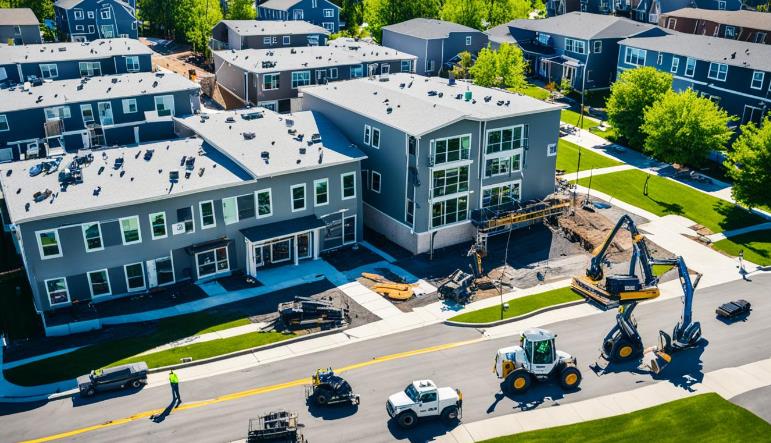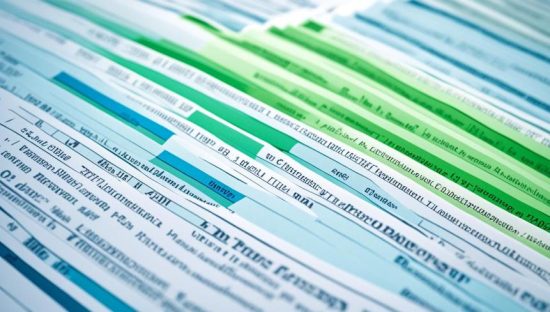
Did you know that commercial loans for rental properties are a thriving market, with billions of dollars in loans being issued each year? Investing in rental properties can be a lucrative venture, but securing a commercial loan to fund your investment is often a crucial step. Whether you’re a seasoned investor or just starting out, understanding the process of obtaining a commercial loan can greatly optimize your investment and increase your chances of success.
In this blog, we will walk you through the six essential steps to get a commercial loan for your rental property. From evaluating the property’s potential to navigating the application process, we will provide you with the knowledge and strategies you need to secure the right loan for your investment.
Commercial Loans for Rental Properties

Commercial loans offer flexibility and tailored solutions for financing rental properties, making them ideal for real estate investors. These loans provide access to larger loan amounts with higher loan-to-value ratios, enabling investments in high-return properties. Flexible terms and repayment options are available, catering to the specific needs of real estate investors. Lenders specializing in commercial loans ensure faster approval and funding due to their expertise in the field. This streamlined process makes commercial loans an efficient choice for expanding your portfolio of investment. Whether you’re experienced or new to real estate investing, commercial loans can help maximize your returns.
Evaluating Your Rental Property’s Potential
When considering investing in a rental property, it is crucial to thoroughly evaluate its potential. This involves assessing various factors that contribute to its profitability and long-term success. In this section, we will explore the key aspects of evaluating a rental property’s potential, including assessing its location and value, projecting rental income, and calculating operating expenses.
Assessing the Location and Value of the Property
The location of a rental property plays a significant role in its potential for success. A desirable location can attract high-quality tenants and generate consistent demand for rentals. When evaluating a property’s location, consider factors such as proximity to amenities, schools, transportation, and employment opportunities. Additionally, research market trends and analyze property values in the area to determine its long-term appreciation potential.
Projecting Your Rental Income
Accurately projecting rental income is crucial in determining the financial viability of a rental property. Start by researching the rental market in the area to understand current rental rates for similar properties. Take into account factors such as property size, condition, and amenities that may impact rental value. Additionally, consider seasonal fluctuations and economic trends that may affect rental demand and adjust your projections accordingly.
Calculating Property Operating Expenses
Calculating the operating expenses associated with a rental property is essential for accurate financial planning and determining potential profits. Operating expenses typically include property taxes, insurance, maintenance, utilities, and property management fees. It is important to carefully estimate these expenses to ensure they are adequately covered by rental income. Consider consulting with professionals or conducting thorough research to ensure accurate expense calculations.
By carefully evaluating your rental property’s potential through assessing its location and value, projecting rental income, and calculating operating expenses, you can make informed investment decisions and maximize your chances of long-term success.
How to Get a Commercial Loan for Rental Property?
If you’re interested in investing in rental properties, you’ll need to secure financing to make your vision a reality. Getting a commercial loan is a common way to fund your rental property purchase. In this section, we’ll break down the loan application process and discuss the commercial loan requirements you’ll need to meet.

Understanding the Loan Application Process
The loan application process for a commercial loan can seem complex, but having a clear understanding of the steps involved will help you navigate through it successfully. Here are the key steps you’ll need to follow:
- Research lenders and compare their loan terms and rates.
- Gather the necessary financial documentation, such as tax returns, bank statements, and property information.
- Submit a loan application to the chosen lender.
- Undergo the lender’s review and assessment process.
- Receive a loan decision, which may come with conditions or additional requirements.
- Fulfill any outstanding conditions and provide any additional requested documentation.
- Complete the loan closing process, which includes signing loan documents and paying any required fees.
- Receive funding for your rental property purchase.
Meeting Commercial Loan Requirements
To qualify for a commercial loan, lenders will typically have specific requirements that you must meet.
Some common commercial loan requirements include:
- A strong credit history and a good credit score.
- Adequate income and cash flow to support loan repayment.
- Adequate down payment or equity in the property.
- A detailed business plan outlining your rental property investment goals and strategies.
- A thorough appraisal of the property’s value.
- Evidence of property insurance coverage.
- Any necessary legal or regulatory documentation.
SMART Goal Setting
To achieve success with your investment property, set SMART goals—Specific, Measurable, Achievable, Relevant, and Time-bound. This framework ensures your objectives are clear, trackable, realistic, aligned with your financial goals, and have a defined timeline. For example, specify “increase rental income by 10% within the next year” rather than a vague goal. Include concrete metrics, such as reducing vacancy rates to 5%, to track progress. Ensure goals are attainable, relevant to your long-term financial plan, and have specific deadlines, like “increase property value by 15% within two years.” Regularly review and adjust your goals to stay aligned with evolving circumstances and market conditions.
Example of SMART Goal Setting for Rental Properties
Let’s explore an example of how SMART goal setting can be applied to rental properties. Suppose you own a rental property and want to increase its monthly cash flow:
- Specific: Increase rental income by $500 per month.
- Measurable: Track the monthly rental income and compare it to the target increase of $500.
- Achievable: Assess the market conditions and analyze potential rental rate increases or cost-saving measures to determine if the goal is attainable.
- Relevant: Increasing monthly cash flow aligns with your overall financial objective of generating passive income.
- Time-bound: Achieve the $500 increase in rental income within the next six months.
Preparing Your Financial Documentation

When applying for a commercial loan for a rental property, it’s essential to have all your financial documentation in order. This documentation provides lenders with the necessary information to assess your loan application and determine your eligibility. By being well-prepared with the required documentation, you can streamline the application process and increase your chances of approval.
To ensure you meet the loan application requirements, here are the key documents you need to gather:
- Income Verification: Lenders will want to see proof of your income to ensure you can afford the loan repayments. This may include recent pay stubs, W-2 forms, or tax returns if you are self-employed.
- Financial Statements: Prepare your financial statements, such as profit and loss statements and balance sheets, to provide a comprehensive overview of your financial position. This information helps lenders evaluate your ability to repay the loan.
- Bank Statements: Be ready to present your bank statements for the past few months. This documentation demonstrates your financial stability and provides insight into your cash flow.
- Credit History: Lenders will assess your creditworthiness by reviewing your credit history. Obtain a copy of your credit report to ensure its accuracy and address any issues or discrepancies before submitting your loan application.
Organizing your financial documentation is crucial to keep everything in order. Create a separate folder or digital file to store all the required documents. Make sure they are easily accessible when it’s time to submit your loan application. Additionally, double-check each document for accuracy and completeness to avoid unnecessary delays or complications during the underwriting process.
Finding the Right Commercial Lender
Finding the right commercial lender is crucial for securing a loan for your rental property. Evaluate different types of lenders, such as traditional banks, credit unions, online lenders, and private investors, considering their pros and cons. Assess potential lenders based on their reputation, market experience, loan terms, and responsiveness. A strong relationship with a responsive lender can streamline the loan process and ensure a smooth transaction. Carefully selecting the right commercial lender can significantly impact the success of your rental property investment.
Navigating the Application Process
Applying for a commercial loan for your rental property can seem like a complex process, but with the right guidance, it can be manageable and successful. In this section, we’ll walk you through the loan application process, providing insights and tips on each step to help you navigate smoothly from start to finish.
1. Loan Application Timeline
Understanding the loan application timeline is crucial as it helps you set realistic expectations and plan accordingly. The process typically consists of several stages, including document submission, loan officer review, underwriting, and loan approval. While the exact timeline may vary depending on various factors, such as the complexity of your application and the lender’s workload, it’s essential to be prepared for potential delays.
2. Document Submission
Submitting the required documents is a critical step in the loan application process. Lenders usually have specific documentation requirements, which may include financial statements, tax returns, lease agreements, property appraisals, and a business plan. It’s important to ensure that all documents are complete, accurate, and organized to avoid unnecessary delays or complications.
3. Loan Officer Review
Once you’ve submitted your documents, a loan officer will review them to assess your eligibility and the financial viability of your rental property. They will evaluate factors such as your credit history, income, property value, and potential rental income. It’s essential to provide any additional information or clarifications requested by the loan officer promptly.
4. Underwriting
During the underwriting stage, the lender’s underwriting team will conduct a comprehensive analysis to assess the risk associated with your loan application. They will review your financial documents, property appraisal, credit history, and other relevant factors to determine whether your application meets their lending criteria. This process may take several weeks, and it’s important to be patient and responsive to any inquiries or requests from the underwriting team.
5. Loan Approval
Upon successful completion of the underwriting process, you will receive a loan approval decision. If approved, you will be provided with the loan terms, including the interest rate, loan amount, and repayment schedule. It’s crucial to carefully review the terms and seek clarification if needed before accepting the loan offer. Once you accept the offer, the loan will move into the closing stage.
Loan Underwriting and Approval Criteria
When applying for a commercial loan for your rental property, understanding the loan underwriting and approval criteria is crucial. Lenders consider the debt service coverage ratio (DSCR) to ensure the property’s income can cover mortgage payments, typically requiring a DSCR of at least 1.25. Your credit score is also evaluated, with a good score significantly impacting your loan eligibility. Additional factors include the property’s occupancy rate, value, condition, your financial history, and experience managing rentals. Providing detailed financial documents and a clear business plan can enhance your application and increase your chances of loan approval
Maximizing Your Investment with the Right Loan Structure

When applying for a commercial loan for your rental property, it’s crucial to build a strong case for loan approval. Lenders carefully evaluate borrower credibility, property value enhancement measures, and financial stability to assess the risk associated with the loan. By taking strategic steps to strengthen these aspects, you can increase your chances of securing a favorable loan approval.
Improving Borrower Credibility
- Review and improve your credit score by paying off outstanding debts and consistently making timely payments.
- Reduce your debt-to-income ratio by minimizing your existing debts.
- Prepare and organize financial documentation, including tax returns, bank statements, and proof of income.
- Provide evidence of consistent rental income from your property, such as lease agreements or rental history.
Enhancing Property Value
- Invest in property renovations and upgrades that increase its value, such as kitchen remodels or energy-efficient improvements.
- Showcase the potential for rental income growth by highlighting amenities, proximity to popular locations, and positive neighborhood trends.
- Provide documentation of recent property appraisals or assessments to demonstrate the property’s value.
- Include a detailed property management plan that outlines your strategies for maintaining and improving the property.
Demonstrating Financial Stability
- Maintain a healthy cash reserve to show your ability to handle unforeseen expenses or vacancies.
- Exhibit a steady income stream from reliable sources, such as employment or other rental properties.
- Outline your long-term financial goals and demonstrate your commitment to preserving the property’s income-generating potential.
- Provide evidence of a solid financial track record, including a history of responsible financial management.
By focusing on these key areas, you can present a compelling case to lenders and increase your chances of loan approval. Remember to provide clear and concise documentation that supports your claims and showcases your commitment to financial responsibility and property value enhancement.
How to Find a Profitable Rental Property?
When it comes to investing in rental properties, finding profitable opportunities is essential for long-term success. But how do you identify properties that will generate a high return on investment? It all starts with a thorough property search and careful analysis. Here’s how:
1. Conduct a comprehensive investment property search: Begin by leveraging online resources, real estate listings, and local networking to identify potential rental properties. Consider factors such as location, property type, and market trends to narrow down your options.
2. Analyze potential investment properties: Once you have a list of potential properties, perform a detailed property analysis. Consider factors such as rent potential, vacancy rates, repair costs, and property appreciation. This analysis will help you determine if a property is worth investing in.
3. Conduct market research: Understanding the local rental market is crucial for finding profitable properties. Look into rental demand, rental rates, tenant demographics, and rental regulations in the area. By conducting market research, you can identify high-demand areas and properties that are likely to attract reliable tenants.
Remember, finding profitable rental properties requires careful research and analysis. By following these steps and conducting due diligence, you can increase your chances of investing in a rental property that will generate a strong and consistent return on investment.
FAQs on Loan for Rental Properties
Is a commercial loan easier to get?
Obtaining a commercial loan can be more challenging compared to getting a residential mortgage. Lenders typically have stricter requirements and underwriting processes for commercial loans, including assessing the property’s potential income and the borrower’s financial stability. However, meeting the necessary criteria and working with the right lender can increase your chances of approval.
How do I avoid a 20% down payment on an investment property?
Avoiding a 20% down payment on an investment property can be challenging. However, there are alternatives, such as exploring loan programs that offer lower down payment requirements or partnering with other investors to pool resources. Some lenders may also consider other factors, such as the property’s potential income, when determining down payment requirements.
What are the requirements for a DSCR loan?
DSCR stands for Debt Service Coverage Ratio and is an important factor that lenders consider when evaluating loan applications for commercial properties. The requirements for a DSCR loan vary among lenders, but typically, a DSCR of 1.25x or higher is desired. This means that the property’s net operating income should be at least 25% higher than the loan’s annual debt service (principal and interest payments).






